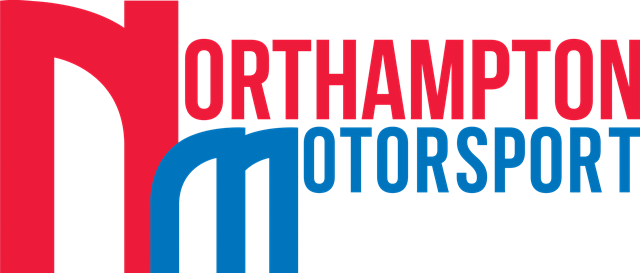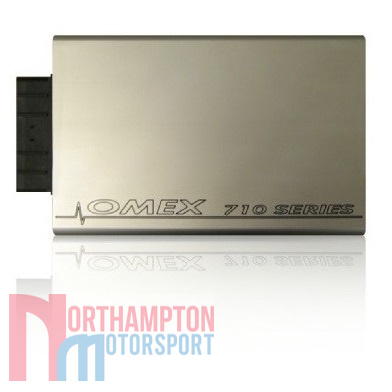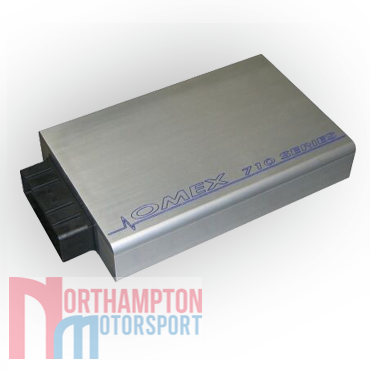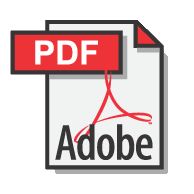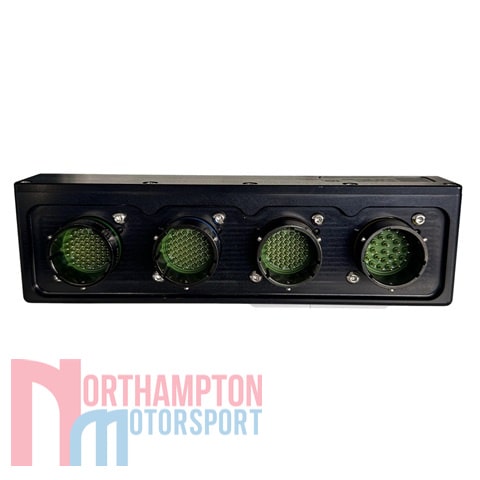Description
The Omex 710 Engine Management System is an ultra high performance ECU system designed specifically for users who require a high spec ECU at an excellent price for their engines.
With up to 6 ignition outputs and up to 12 fuel outputs, the Omex 710 is suitable for up to 12 cylinder engines.
Omex 710 ECU Specification:
Features
- Professional level Engine Management System
- Suitable for up to 12 cylinder engines
- Up to 12 cylinder distributorless (DIS) or 6 cylinder ‘coil on plug’ ignition with no external amplifiers
- Up to 12 cylinder ‘coil on plug’ ignition using external amplifiers
- Sequential fuel injection for up to 12 cylinder engines
- Inner and outer injectors mapped on both speed and load
- Programmable load and speed sites
- TPS or MAP can be used for main load sensing
- Wide range of crank trigger patterns are suitable (user programmable)
- Turbo wastegate control
- Turbo anti-lag system
- Constantly variable cam control (contact Omex for systems currently compatible)
- Launch control
- Inbuilt 1/2MB data logging
- Narrow and wide band lambda support
- Twin lambda sensors
- Individual cylinder trims for fuelling
- Push/pull, and single line idle controls in addition to scattered spark control
- Knock sensing capability
- Security protected calibrations
- Full throttle gearchange
- Intercooler water spray control
- Water injection control
- Nitrous ignition retard
- Cooling fan control
- Internal 1 bar MAP sensor for barometric correction
- Uses the latest version of the superb MAP3000 Windows programming software
- Suitable for normally aspirated or boosted engines
- Inbuilt independent fuel and ignition rev limiters
- Tachometer, Shift Light and Fuel Pump outputs (and other programmable outputs)
- Magnetic or Hall Effect crank and cam sensors
- Automatic interpolation between mapped sites
- Sophisticated acceleration fuelling setup
- Battery voltage compensation table for fuel injectors (not just a simple number)
- Battery compensation and engine speed compensation for coil charge time
- Mappable coolant temperature compensation for engine warm-up
- Air & coolant temperature compensation for fuel injection pulse width
- Separate cold cranking and decay tables in addition to warm-up fuelling
- User settable ignition trim based on air temperature, coolant temperature, and barometric pressure
- Separate start advance for cranking provides easy starting for high compression engines
- Deceleration fuel cutoff feature for road engines
- Maximum recommended engine speed 12,750 RPM
- High strength billet machined aluminium case for physical and electrical protection
And lots, lots more!
Inputs
Engine Speed and position is read from a pattern of teeth on the crank and optionally a pattern of teeth on the cam if sequential injection is required. Most manufacturers patterns are already known such as Ford 36-1, Bosch 60-2, Rover (18-1 twice and late K series), Honda S2000, Honda K20, Toyota etc If using an engine without a crank trigger pattern, an external trigger wheel can be fitted. The trigger wheel is a general-purpose part and will require machining to fit the crank pulley with the crank position sensor mounted facing it.
The ECU needs an input of engine load. The Omex 710 ECU can use an input of throttle position or manifold absolute pressure (MAP). Most normally aspirated engines will use an input of throttle position as this gives excellent throttle response. Forced induction engines need to use MAP as there is no direct relationship between throttle angle and engine load due to the variable of boost pressure. However, forced induction still requires throttle position sensor (TPS) input for idle condition and acceleration fuelling information.
If using the engine’s original inlet system, the OE sensor can normally be used. Omex stocks a variety of different throttle position sensors to suit different applications if not using the OE inlet.
The ECU needs an input of engine load. The Omex ECU can use an input of throttle position or manifold absolute pressure (MAP). Most normally aspirated engines will use an input of throttle position as this gives excellent throttle response. Forced induction engines need to use MAP as there is no direct relationship between throttle angle and engine load due to the variable of boost pressure. However, forced induction still requires throttle position sensor (TPS) input for idle condition and acceleration fuelling information. It is possible to also use TPS as the main load sensor with a boost compensation from the MAP sensor. The rating of MAP sensors is absolute, not boost pressure. Therefore a 2bar sensor is for up to 1bar boost and a 3bar for up to 2bar boost.
The coolant temperature sensor is used to give user definable cold running fuel correction based on coolant temperature. A user definable ignition retard based on coolant temperature is also possible. The input from the coolant temperature sensor can be user calibrated in the ECU software allowing nearly all standard sensors to be used. Omex can supply a sensor with a known calibration if required.
The air temperature sensor is used to give user definable fuel correction and ignition retard based on inlet air temperature. The input from the air temperature sensor can be user calibrated in the ECU software allowing nearly all standard sensors to be used. Omex can supply a sensor with a known calibration if required.
The ECU can use inputs of narrowband or wideband (with external adaptor) lambda to make constant trims to the fuelling for best emissions and fuel economy without affecting ultimate power.
2 inputs are available for ‘V’ engines.
Most modern vehicles are fitted with a lambda sensor as standard. If one needs to be fitted to an engine that does not have the mounting boss in the exhaust, Omex can supply a mild steel boss to be welded into the exhaust.
A dedicated knock sensor input allows sensing of knock and user definable ignition and fuelling trims based on the knock input. An output could also be set to indicate knock to the driver whilst running the engine. Many newer engines have sensors as standard, whilst older engines can have the sensor fitted. This sensor is not required for engine running, it is an optional safety feature.
Full Throttle Gearshift allows the gear to be changed without releasing the throttle, reducing the time taken for the shift, and in turbo applications reducing the slow down of the turbo speed. A clutch switch or gear lever switch must be fitted to indicate that the gear change is occurring, at which point the ECU can retard the ignition in a user definable manner to reduce engine torque and allow the shift.
The 710 ECU’s selectable pins allows any of the remaining input pins to be used for any of the auxiliary functions.
Injectors
The 710 series ECU can control up to 12 injectors sequentially with controls for staged injectors. Injector start angle can be mapped and single cylinder trims are possible. Injectors should be high impendence, but low impendence injectors can be used with ballast resistors. Omex can supply injectors in a range of flowrates, both normal ‘Bosch’ size and ‘Picos’.
The ECU has 6 coil outputs allowing up to 12cyl wasted-
The Omex 710 ECU can control idle by scatter spark, or if the engine is fitted with an idle air bypass motor, can control single wire or twin wire idle motors.
Turbo Anti Lag: As found on WRC rally cars, turbo anti-
Boost Control: Boost pressure is regulated by the turbo wastegate which is opened at a boost pressure set by the actuator. To increase boost pressure at which the the wastegate is opened, the actuator needs to see a lower pressure than actually exists in the inlet manifold. The ECU can control a solenoid or air injector to do this. The solenoid or air injector can be turned off / on to give low (actuator level) and high (ECU controlled) boost.
VTEC single switch point cam control with user definable engine load, throttle position, and engine speed switch point and user definable hysteresis levels to aid smooth transitions from one cam profile to the next. Ignition and fuel trims are also possible in the VTEC mode.
The 710 ECU also features twin channel infinitely variable cam control for engines such as the Honda K20 iVTEC.
A button activated launch control mode allows the driver to hold the engine with a user definable, temporary lower rev limit with ignition retards, ignition cuts, or a combination of both.
Turbocharged engines gain from increased launch boost with decreased launch engine speed; same power, lower engine speed. The further the throttle is pressed, the greater the boost, but with no increase in engine speed.
2 software controls allow any of the output pins to be used to control up to two cooling fans or a dual speed fan.
Normally aspirated engines with very light flywheels can be launched consistently at lower engine speeds with no engine ‘bog down’.
A shift light output allows an LED or bulb to be set to light at a user definable engine speed to indicate the optimum gearshift point. Omex can supply a 5mm or 10mm ultrabright LED with mounting bezel.
An adjustable frequency output allows most tachos to be controlled by the ECU.
Fuel pump controls can control a fuel pump relay to prime the pump at ignition ON and then run the pump when the engine is being run.
The Omex 710 series ECU can store 15 of its parameters (inputs, outputs, and all the calculations in between) at user selectable rates on the inbuilt 1/2MB memory chip. Unlimited recording of the parameters can be made whilst connected live to a PC. The results of this logging can be viewed using the analysis tool DATA2000 (see software section)
The Omex 710 ECU’s selectable pins allows any remaining pins to be used for Auxiliary Outputs.
Here at Northampton Motorsport, we also offer a full wiring and fitting service as well as engine calibration on our in house Superflow AD30 2 wheel drive chassis dyno. For more information, please contact us and a member of our team would be happy to assist with your enquiry:
Estimated dispatch time within 3 working days.
Picture for illustration purposes only. Actual parts may differ slightly in appearance.
